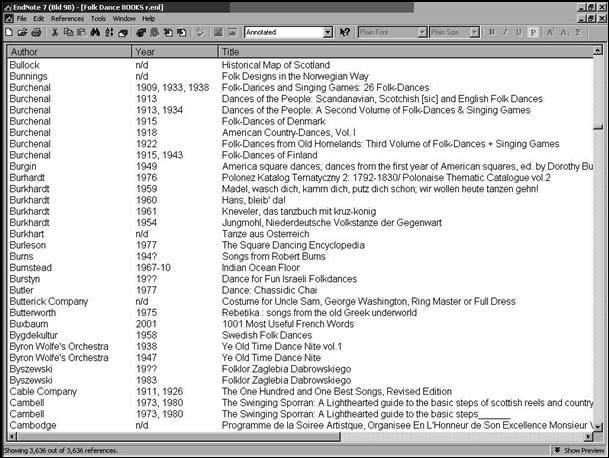
|
The Society of Folk Dance Historians (SFDH)
Building the Folk Dance Archive
[
Home |
About |
Encyclopedia | CLICK AN IMAGE TO ENLARGEb> |

|
INTRODUCTION
"Archives, Part One" presented three reasons why folk dancers avoid archives:
- Few people understand the nature of archives.
- Archives threaten the way some people want to dance.
- Archives threaten the social capital of some veteran folk dancers.
As a result, we forget our dances, our teachers, and our history. To restore our past and perhaps to extend our future, we must collect, organize, digitize, and publish our archives.
"Archives, Part Two" explained the differing treatment required for library, archives, ephemeral, and museum items that you will receive. We left that article with boxes of donated folk dance "stuff" still unopened.
PROCESSING DONATIONS OF FOLK DANCE "STUFF" (Part b)
INVENTORY
When you have the time and space, unpack the boxes, keeping a list of the items in each box and the shipping label details, including postage. Unpack the boxes and group the items (maintaining their original order), as library, archives, or museum items. At this point, you must APPRAISE the enduring value of the items as they reflect on the life and activities of the creator and further the mission of your institution. This is where your Ph.D. in history comes in handy!
ACKNOWLEDGE
You ARE chartered as a 501(c)(3), aren't you? So as soon as possible, send the donor a letter of thanks following current IRS guidelines. Be careful! The rules change! Currently, I fill out and enclose the IRS Form 8283 "Noncash Charitable Contributions" with every acknowledgment.
PROCESSING LIBRARY ITEMS
As you inventoried the donation, you placed all the "paper-based" publications (books, journals, phonograph record inserts) on your "library" shelves. Video and audio recordings (phonograph records, films, magnetic tapes, CDs, DVDs, etc.) went on separate "library" shelves to make caring for them easier. You stored all items vertically, side-by-side, rather than in piles, both to facilitate pulling them off the shelf and to minimize storage damage. Beyond this, audio- and videotapes and films have their own rules for storage, so check with a specialist.
If your library has a CATALOG, add in the new items immediately. Otherwise, you will have to re-catalog your ENTIRE library, sooner or later, when you forget what has been done and what hasn't. At the Society of Folk Dance Historians (SFDH), we also INDEX each item for rapid access to the dances. Many word processing, spreadsheet, database, and bibliographic programs will work for cataloging and indexing. Here is a screen shot of the one we use.

Arrange your library shelves by a standard library shelving system, or even by author in straight alphabetical order. Arrange your phonograph records by size: the 12" records together, the 10" records together, and the 7" records together. Within each group, arrange the records alphabetically by record label and number. Remember, your purpose is to LOCATE an item, not to make it feel at home among similar items!
EPHEMERA
This is where YOUR NEEDS come into play. Personally, I need to find dance descriptions, so I shelve SYLLABI and MAGAZINES (e.g., Let's Dance, Viltis, The Folk Dancer) with the books, because I refer to their dances as frequently as I refer to the books. Other ephemera such as flyers, programs, and newsletters (very few newsletters have useful dance descriptions) stay in the "archives," described next, because they tell more about the events and context of folk dance history than they do about individual folk dances.
ARCHIVES ITEMS
As I said before, you must keep the creator's ORIGINAL ORDER of items. But most creators throw away archives: "Oh! I didn't know you wanted those old letters!" In other donations, the small number of documents that you DO receive will need no ordering. Just put them all into a folder and move on to something else.
However, some donors send many documents. If you MUST rearrange them, be gentle. As an epistemological positivist who embraces that whole "cause and effect" thing, I tend to order items chronologically, but you must do what you think best. Archival theory says to group individual items (letters, memos, photos, etc.) into folders. Group folders into series of folders. Group series into fonds (remember, fond = all the archives stuff that one person sends you). Personally, I arrange fonds alphabetically, by state: Alabama, Alaska, Arizona, Arkansas, etc. Fonds of INDIVIDUALS are interspersed, for example: Herman, Hilburn, Holden, Idaho, Illinois, Indiana, Iowa, Kansas, Kentucky, La Farge, Louisiana, Lowrey, Maine, Massachusetts, McCutchan, etc. For series and folders, you might arrange one alphabetically and the other chronologically to allow triangulation on a document by both alphabet and by year. For example, the Rickey Holden fond has this structure, where S = series and F = folder:
S I General Material providing an overview of RCH (alphabetical)
F 1 Family history (chronological)
F 2 Activities outside folk and square dancing (chronological)
S II Square dance calling activities (chronological)
F 1 Correspondence (alphabetical)
F 2 Publicity, photos, and clippings (chronological)
S III American Squares magazine involvement (chronological)
F 1 Correspondence (alphabetical)
F 2 Rough drafts of articles, and file photos (alphabetical)
S IV World teaching tours 1956-1963 (chronological)
F 1 Correspondence (alphabetical)
F 2 Publicity, photos, and clippings (chronological)
F 3 Reports and publications by RCH (chronological)
S V World performance tour 1959 (alphabetical)
F 1 Correspondence (alphabetical)
F 2 Applications from dancers (alphabetical)
and so on.
FINDING AIDS
For LIBRARIES, we have the catalog and any indexes. ARCHIVES, however, have unique items, and archives finding aids are rather peculiar, so consult an archivist if you really want to do it right. In the meantime, do as little as possible, and keep handy the inventory that you created when you first opened the donated boxes.
So far, this has been pretty standard librarianship and archival enterprise. But as you may have noticed, the world of folk dance is anything but standard. The next installment will discuss counter-intuitive situations and suggest responses. As I said in the first installment, you may not create the perfect archive, and you may not have permission, but DO IT ANYWAY.
(To be continued in Part 4)
Used with permission of the author.
This page © 2018 by Ron Houston.
Please do not copy any part of this page without including this copyright notice.
Please do not copy small portions out of context.
Please do not copy large portions without permission from Ron Houston.